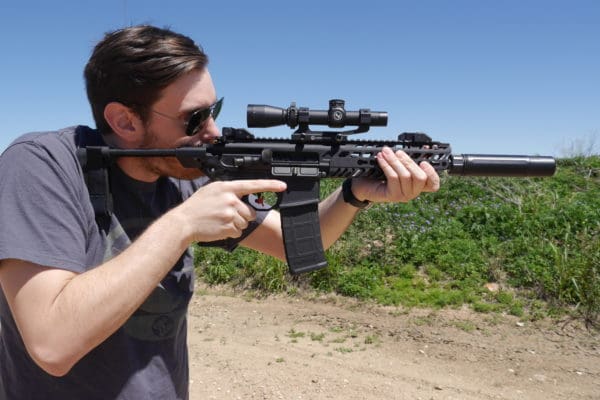JULY 2018 UPDATE: It has been clarified that you CAN legally shoulder an AR-15 pistol equipped with a stabilizing brace, irrespective of the manufacturer of the brace. That means a Sig arm brace (e.g. this pistol brace) IS legal to use in this manner.
In 2013, SB Tactical introduced the AR-pistol “stabilizing brace.” Navy veteran Alex Bosco designed the brace for a wounded warrior who had lost an arm in combat. The ATF approved the device for general use. The People of the Gun soon realized that an AR-15 pistol equipped with a stabilizing brace could be used as a short-barreled rifle (SBR). Justifiably worried about falling afoul of onerous, expensive, time-consuming and extremely punitive NFA requirements, more than a few law-abiding Americans wrote the ATF asking for clarification.
In January 2015 the ATF released an open letter answering their concerns. The Bureau stated that the act of placing an AR-15 pistol on the shooter’s shoulder constituted a “redesign” of the firearm, instantly turning it into an unregistered SBR. You could fire a brace-equipped AR pistol from your hip, your chest, even your forehead. Shoulder it, though, and you’re committing a federal felony.
Sales of pistol arm braces dropped as concerns about legality grew. Despite the fact that the ATF would have had a very difficult time defending their decision in court, no one wanted to be “that guy” to test it.
For the last two years the issue has simmered in the background. In February a leaked ATF memo indicated that a new ruling was on its way. TTAG can now reveal that the ATF has issued a new opinion letter clearing the way for owners of SB Tactical stabilizing braces to shoulder their “pistols.”
Click here to read the full ATF opinion letter. Here’s the important bit:
With respect to stabilizing braces, ATF has concluded that attaching the brace to a handgun as a forearm brace does not “make” a short-barreled rifle because in the configuration as submitted to and approved by FATD, it is not intended to be and cannot comfortably be fired from the shoulder.
If, however, the shooter/possessor takes affirmative steps to configure the device for use as a shoulder-stock — for example, configuring the brace so as to permanently affix it to the end of a buffer tube, (thereby creating a length that has no other purpose than to facilitate its use as a stock), removing the arm-strap, or otherwise undermining its ability to be used as a brace — and then in fact shoots the firearm from the shoulder using the accessory as a shoulder stock, that person has objectively “redesigned” the firearm for the purposes of the NFA.
Therefore, an NFA firearm has not necessarily been made when the device is not re-configured for use as a shoulder stock — even if the attached firearm happens to be fired from the shoulder.
Bottom line: if an unmolested SB Tactical stabilizing brace is attached to the buffer tube of an AR-15 pistol, the resulting firearm can be legally shouldered and fired without “making” it a short-barreled rifle under the National Firearm Act. However as soon as you do anything to change the brace (even just removing the strap) you have now “made” an SBR.
This letter applies solely to pistol arm braces which have been submitted to the ATF FTB branch and have received approval. SB Tactical is the only maker to have received this approval. If you have a non-SB Tactical pistol brace, this ruling does not apply to your brace. Shoulder those at your own risk.
Sources also tell TTAG that the ATF will be designing a litmus test to identify the difference between a stock and an arm brace (rather than the Supreme Court “I know it when I see it” approach). The test’s protocols are as yet unknown, but the mention of “comfort” above may mean that the ATF will be looking to ensure that the length of the arm brace is short enough to make it inconvenient to shoulder among other requirements.
Is this a reversal of the ATF’s policy? The ATF says no — in their letter they specifically call this a “clarification” of their policy and not a revision. But I can’t help feel that this is as close to a non-reversal reversal as we can expect from the bureaucratic nightmare that is the U.S. government.
